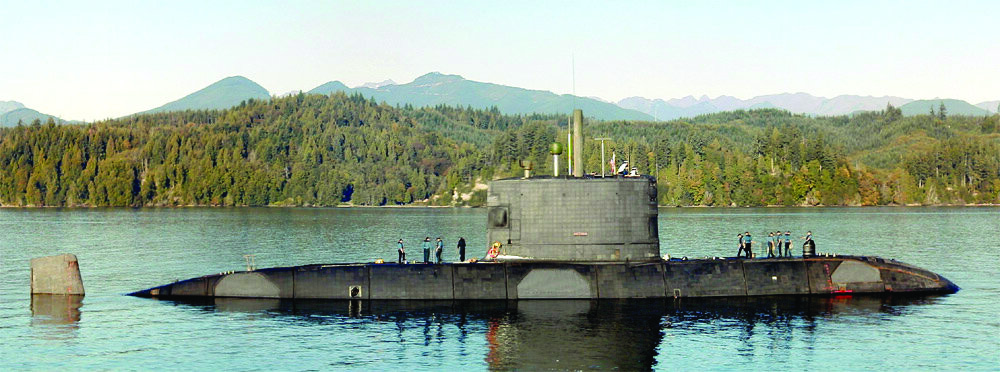by David Pugliese
THE ROYAL CANADIAN NAVY wants new submarines to replace its Victoria-class boats and has already embarked on a communications plan to convince the public to support that multi-billion dollar program.
Canada will eventually have to replace the aging Victoria class submarines currently in service with the RCN.
In the early summer of 2021 the word went out among some in the defence industry that the RCN would launch a public rela- tions drive to put the purchase of new submarines on the Liberal government’s agenda.
What occurred in the following six months was a testament to the RCN’s use of “stakeholders” and military-friendly journalists to try to shape the defence agenda in Canada.
The campaign kicked off in July when “defence officials revealed” to Lee Berthiaume, a journalist with the Canadian Press, that the RCN was establishing a submarine project office to “inform timely governmental decision-making about a potential replacement class of submarines.”
For good measure Berthiaume quoted David Perry of the Can- adian Global Affairs Institute, an organization closely aligned with the Department of National Defence and one that has received both DND and defence industry funding. In Berthiaume’s July 14 article Perry said the RCN’s need for new submarines could be justified given Russia and China had both ramped up their underwater capabilities in recent years.
The same day Evan Solomon, the popular and pro-military host of shows on both CTV and CFRA radio station, was ready to add to the communications initiative. Solomon had retired Vice Admiral Mark Norman, the former RCN commander, on his radio show to talk about the critical need for the subs to be replaced.
“If the pandemic taught us that you’ve got to be ready for the next threat, you’ve got to be ready,” Solomon told his listeners. “We didn’t have enough PPE. We didn’t have enough vaccines. Then when you’re in the threat people say, ‘Oh my God, We weren’t ready.’ Subs are the very same thing. The next threat is not here but you’ve gotta have that insurance policy. If there’s a threat and you don’t have the subs it’s like having no PPE during the pandemic. It’s nuts.”
Not unsurprisingly, Norman enthusiastically agreed.
Also on that same day, the Ottawa Citizen newspaper pub- lished an opinion column by Robert Smol in which the retired Canadian Forces member lamented about the aging Victoria-class subs. Canada, Smol warned, was lagging behind allies who were all buying new boats.
On July 23, the Globe and Mail newspaper carried an opinion piece by naval historian Alexander Howlett. Howlett claimed Canada could not claim Arctic sovereignty unless it buys new submarines. For good measure he warned that both China and Russia were expanding their influence in the Arctic.
In mid-September the RCN’s submarine PR push hit a new high with the Sept. 15 announcement that Australia would be purchasing nuclear submarines from the U.S., with participation from the United Kingdom. The subs were the centrepiece of a new defence alliance between the three nations.
RCN supporters immediately characterized the development as a significant snub to Canada and the result of the Liberal government not spending enough on defence. David Perry argued Canada was being left out of the “club” because it wasn’t pulling its weight militarily. Stephanie Carvin and Thomas Juneau, both academics with close ties to the DND, also used the Australian- U.S.-UK alliance to support their often-repeated argument that Canada needed to invest more into defence.
In reality, the three-nation alliance was needed because of the exchange of highly sensitive nuclear technology and the fact Australia planned to spend billions buying the new boats from the Americans. The deal was initially estimated to cost $71 billion but there are already estimates the purchase price tag will be more than $170 billion. Whatever the cost, the deal supports a lot of American jobs and buys a lot of good will from the U.S.
What was supposed to be one of the key milestones in the RCN’s public relations campaign came on Sept. 23 when the Macdonald-Laurier Institute released a report by Jeffrey Collins, an assistant professor at the University of Prince Edward Island and a fellow at Perry’s Canadian Global Affairs Institute. That paper called for the Canadian government to purchase new sub- marines but did not provide a price tag. Collins did acknowledge any acquisition would cost more than the several billion dollars the RCN estimated years ago.
VISSC was awarded in 2008 to the Canadian Submarine Management Group, now known as Babcock Canada Inc. to assist the Department of National Defence in delivering on the requirement to sustain and perform in-service support to meet the Royal Canadian Navy’s operational mandates.
The original life expectancy of the Victoria-class Subma- rines was the mid-to late-2020s. However, with the release of Canada’s Defence Policy, Strong, Secure, Engaged in June 2017, Canada has committed to operating and modernizing the Victoria-class submarines to ensure their continued ef- fectiveness out to the mid-2030s.
The Victoria-class submarines operate in open-ocean and deep-sea environments, where they are exposed to pressure-induced stresses resulting from changes in depth, extreme weather conditions, and the corrosive properties of seawater on an on-going basis, the National Defence noted. As such, these vessels, like all submarines, face significant wear and tear, which necessitates a rigorous in-service maintenance schedule to assure the safety of the crew and the submarine, department officials pointed out.


